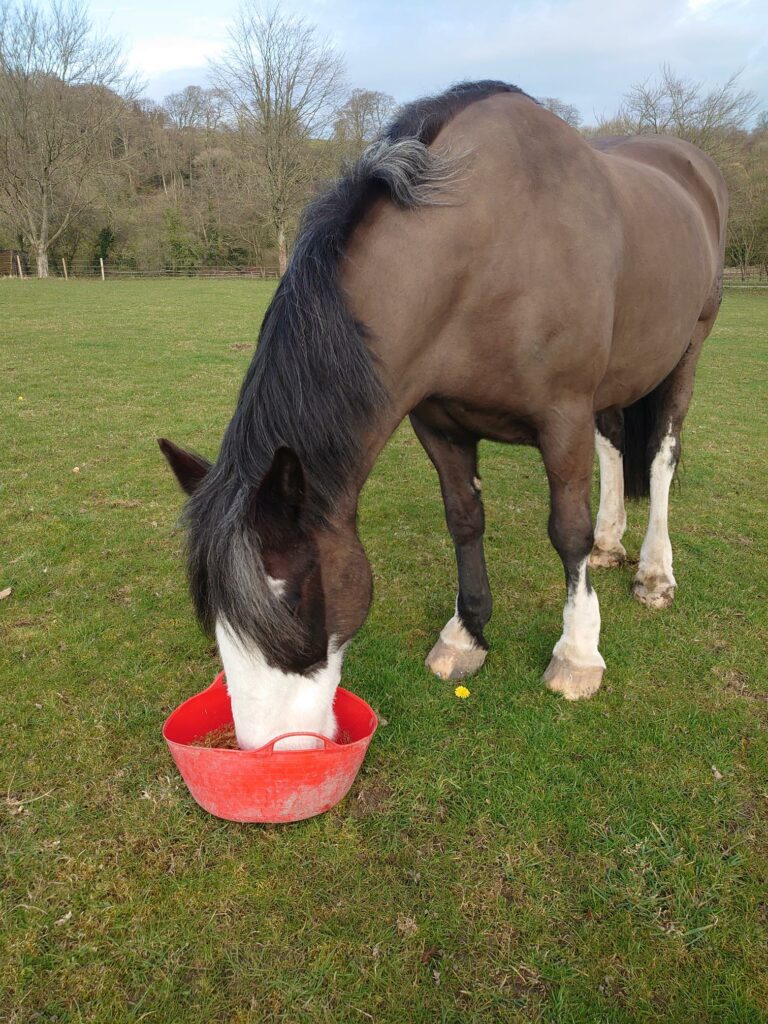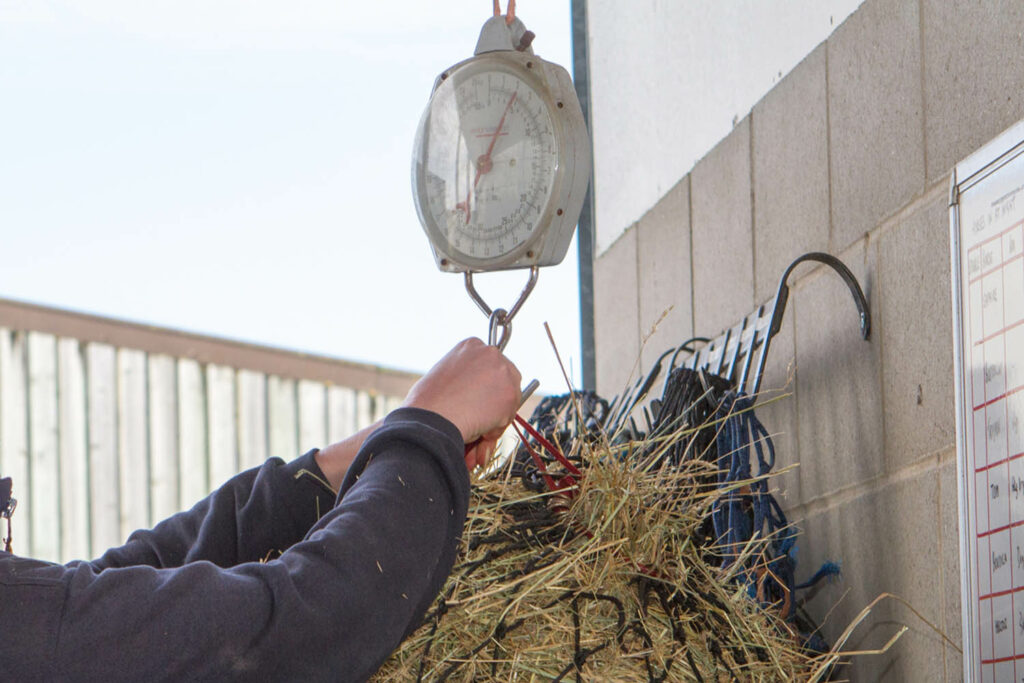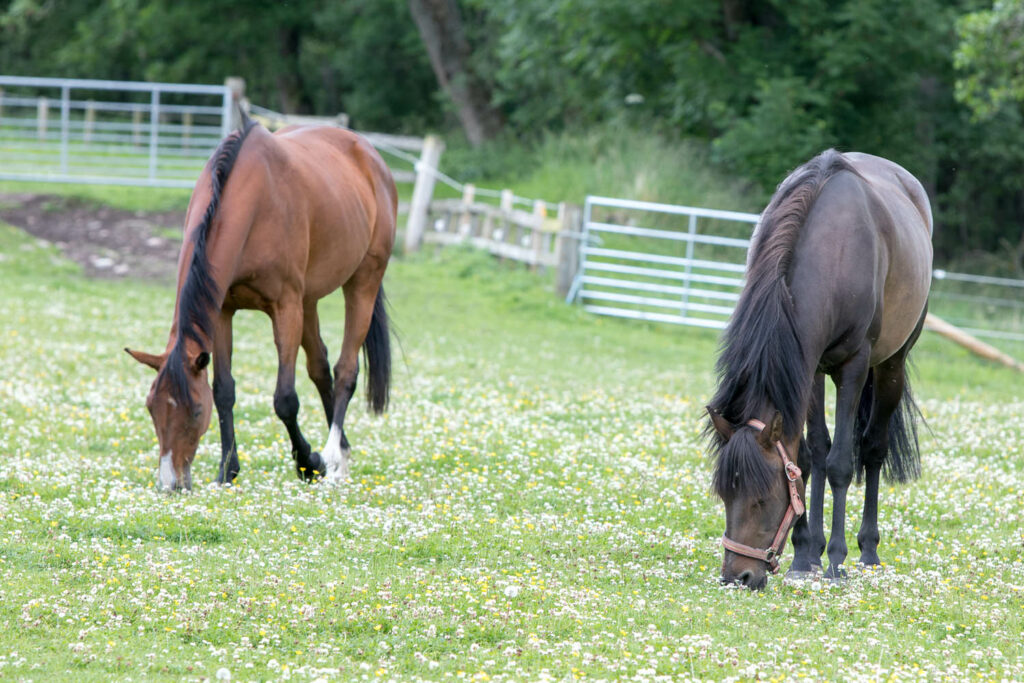Our top 10 nutrition essential considerations:
1. Forage
Every horse’s diet should be forage-based. Forages such as grass, hay, haylage or straw contain fibre (plant cell walls) which is essential for maintaining gastrointestinal health. The forages because they take a long time to chew provide horses with a means of performing important natural behaviours.
2. The stomach
The horse’s stomach is small in comparison to their size; it is approximately the size of a rugby ball. It is designed for trickle feeding of forage, not large meals. Horses requiring concentrate feeds should be fed little and often, splitting the feeds into as many small meals as possible. It is important that horses always have some forage in their stomach because it helps to prevent the stomach acid from splashing onto the soft upper part of the stomach and causing gastric ulcers. If your horse doesn’t have free access to forage, you can feed some hay/haylage or chaff just before exercise, for example while tacking up.

3. The hindgut
The hindgut of the horse is made up of the caecum, large colon, small colon, rectum and anus. The caecum and large colon are the main fibre-processing sections of the horse’s digestive system. They contain good bacteria and micro-organisms which are essential for breaking fibre down so the horse can produce energy. Ensuring your horse has plenty of forage in their diet can help prevent colic, particularly the types of colic where the intestines can twist, as it is harder for them to twist when full of forage. However, water should always be available to help move the forage through the intestines to help prevent impaction colic.
4. Individual diet planning
Each type of horse has its own set of dietary needs and should have their own individual diet plan. There will be differences in feed and forage requirements for horses in or out of work, differences based on their age, how they live (whether they are stabled or live out), their weight, body fat (condition) score, medical conditions, time of year and type of forage fed. All these factors should be taken into consideration when choosing what to feed your horse.

5. Workload
Horses’ workloads can be split into 4 categories: maintenance, light work, medium work and hard work. An example of a horse at maintenance would be a companion horse. As you progress up through each of the workload categories, the horse’s energy requirements increase. For example, a horse in light work may hack 3 times a week and lightly school once whereas a horse in hard work could be preparing for a 3-day event. These horses will have different nutritional requirements for maintenance of health and expected performance level. Any additional nutritional requirements should first be met through increased amounts of good-quality forage, before concentrated feeds are added to the diet. Workload definitions can be a useful guide, but it is important that you assess your horse as an individual and only introduce concentrate feed if your horse’s body condition and energy levels indicate it is required.
6. Weight management
If horses are fed excess food in relation to their energy demands and workload, then they will gain fat. It is important to monitor your horse’s weight using a weigh tape or weigh bridge. You should fat score your horse at the same time as weighing them. By monitoring your horse’s weight, fat score condition, you can adjust either their diet (adjustments should first be made to concentrate feed levels rather than amount of forage provided) and/or exercise plan to ensure they stay at their optimum weight.
7. Behaviour
Feeding a forage-based diet mimics horses’ natural feeding practices and promotes their mental well-being. Horses fed high-fibre diets show fewer unwanted behaviours in the stable and under saddle than those fed low-fibre diets. Ideally, horses should have constant access to forage. If this is not possible, they shouldn’t be left without forage for longer than 4–6 hours. For more information, see our webinar ‘Promoting positive health and well-being through diet’.

8. Malnutrition
When a horse’s diet doesn’t meet their needs, then they may become undernourished. Horses that are underweight may have an underlying health condition such as a heavy worm burden or dental issues. If your horse is gaining or losing weight with no obvious cause, seek advice from your vet. The term ‘malnourished’ doesn’t just apply to horses that lose weight and condition – it also refers to those that are overweight. These horses are usually overfed calories but can be undernourished in terms of protein, vitamins and minerals if just being fed forage- make sure you feed a balancer to rectify this. Overweight horses are more likely to suffer from laminitis, osteoarthritis and skin problems.
9. Enrichment
Providing food and forage in different ways helps engage horses’ brains and mimics natural foraging behaviours. This is particularly important for horses who may be stabled for long periods of time, because stabling decreases their movement and opportunity for foraging behaviours. Forage can be provided loose, in hay nets or slow feeders. You can also tie small horse-safe branches up in their stable for horses to browse such as willow and hazel. For more information of how to provide enrichment for horses, see our webinar ‘Promoting positive health and well-being through management’.
10. Equine nutritionists
There is a huge variety of equine feeds, supplements and products available, and navigating through it all to find what your horse actually needs can be tricky. Qualified equine nutritionists can help. You can contact them via feed companies or, if you would like to contact an independent nutritionist, you can search the Association for Nutrition voluntary register.
Popular advice in Well-being essentials

The 3Fs – Friends, forage and freedom
Find out how you can meet your horse’s fundamental needs using the 3Fs

The 5 Domains of animal welfare
Find out how you can meet the species specific needs of your horse using the 5 Domains of animal welfare
Other advice categories
All webinar categories:
Call our Advice Line
+44 (0)1953 497 238Not found the advice or answer you were looking for here? Then our Advice Line is available during office hours, or you can email us on education@worldhorsewelfare.org to let us know what topics you were looking for.


